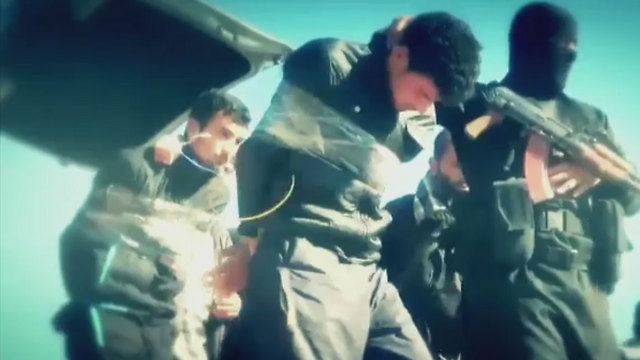Hundreds of Islamic State militants amassed at Israel's border
The Islamic State group's branch in the Syrian Golan has anti-tank missiles, car bombs, machine guns, a few tanks and APCs in its arsenal. Despite its low manpower, the IDF is keeping a close eye on the Yarmouk Martyrs Brigade, as it eats away at the territory of its rival Al-Qaeda.
A few weeks ago a huge explosion rocked the town of el-Hmidaiah, near the Quneitra crossing and 400 meters from the border fence with Israel. IDF troops were dispatched for fear that a mortar shell had fallen in the Ein Zivan area.
After a few hours it became clear that the capabilities of Islamic State supporters over the border were no longer restricted to use of light weapons and machine guns. Two car bombs had exploded at an outpost of the Jabhat al-Nusra rebel organization.

The perpetrators belonged to an outfit identified with IS, whose personnel split off from Jabhat al-Nusra – which is aligned with Al-Qaeda.
On Wednesday, IDF Chief of Staff Gadi Eisenkot toured the border in the Golan Heights along with GOC Northern Command, Maj.-Gen. Aviv Kochavi and Galilee Division Commander Brig.-Gen. Amir Baram.
The IDF has been following the rebel organizations fighting one another in the Syrian Golan, who for a year have controlled around 90 percent of the strip along the border with Israel.
The army emphasizes that these organizations, comprised of extremist Islamists, are not looking to Israel and are currently principally concerned with each other.
However, IS leader Abu Bakr al-Bagdadi's threatening message to Israel last Saturday has given new meaning to the presence of two separate branches of the terrorist group on Israel's borders.
In the south, which the IDF considers to be the greater threat, IS's Sinai branch is active near the border with Egypt. In the north, a smaller – but no less extreme – group, the Yarmouk Martyrs Brigade, is operating in the border area.
The group is relatively small, comprising 600 militants who represent IS in the Syrian Golan. The group controls a 15-kilometer stretch of land on the border with Israel, from the triangular point where the Syrian, Israeli and Jordanian borders meet and northwards.
Within Syria proper the group controls a territory of several dozen kilometers south towards Daraa and north up to Tel Saki.
Revenge for a killed leader
The Yarmouk Martyrs Brigade operates in a "locked-in" area: To its west is Israel, to the south the Jordanian border and to the north, Jabhat al-Nusra – its main rival – which is trying to crush it. However, although Jabhat al-Nusra has control over the territory, the YMB occasionally manages to receive aid and supplies from IS.
YMB rules over about 40,000 out of the 750,000 Syrians who remain in the Syrian Golan, with most of its members coming from the area.
Since October, YMB has managed to take even more territory that had been under Al-Qaeda control. About a month ago, al-Nusra militants killed leader Shuhada Abu Ali al-Baridi, nicknamed "Sheikh al-Ghal" ("the uncle") in a suicide attack inside the organization's headquarters.
Sheikh al-Ghal was replaced by Abu Ubaida, who didn't delay with a response to the killing of his predecessor.
In an ISIS-like act of vengeance, YMB located two alleged collaborators, attached bags packed with explosives to their bodies, and blew them up on camera.
The IS branch in the Syrian Golan has, like Jabhat al-Nusra, conquered posts abandoned by the United Nations Disengagement Observer Force and has been using them as bases. In their possession are numerous types of weapons, most of them captured from the Syrian army, including light guns, heavy machine guns mounted on trucks, anti-tank missiles and a few tanks and APCs.
Nasrallah's threats
The IDF believes the organization will not be in any rush to accept any future order from ISIS to send forces outside of the Syrian Golan, and the branch in the Syrian Golan is seen as having a more local orientation that sticks to its original territory.
Despite there being no intention to carry out a major terror attack against Israel in the form of dozens of armed militants and truck bombs, the IDF's 366th Division, which oversees the border area, is preparing for any eventuality.
Another scenario considered by the IDF is the continuation of effective aid from Russia to Assad's army in the Syrian Golan, which could prod the radical rebels to carry out a terror attack on Israel, making the border area extremely unpredictable.
In the northern and central Golan Heights, the Syrian military today holds only the corridor between Quneitra and Damascus, as well as a few of the Druze areas at the foot of Mount Hermon. Hezbollah operatives who fought on Assad's side in the Syrian Golan have left the area in recent months after helping to repel towns on the strategic road from being overrun.
Further north, the IDF has identified deployment of Hezbollah forces at the Syrian foot of Mount Hermon, as well as deployment of the Lebanese army on the Lebanese side of the Syrian border, with the goal of preventing the westward movement of Islamist rebels.
The IDF has also taken heed of Hezbollah Secretary General Hassan Nasrallah's recent warnings in the wake of the targeted killing of Samir Quntar, which Nasrallah and others attributed to Israel. "We take Nasrallah's statements in his speeches very seriously and are preparing for them," said IDF sources on Wednesday, but added that "Hezbollah also takes what we say seriously."











